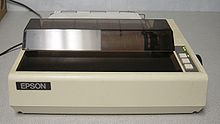This is an old revision of this page, as edited by DigitalIceAge (talk | contribs) at 07:00, 29 November 2024. The present address (URL) is a permanent link to this revision, which may differ significantly from the current revision.
Revision as of 07:00, 29 November 2024 by DigitalIceAge (talk | contribs)(diff) ← Previous revision | Latest revision (diff) | Newer revision → (diff)| This article is actively undergoing a major edit for a little while. To help avoid edit conflicts, please do not edit this page while this message is displayed. This page was last edited at 07:00, 29 November 2024 (UTC) (33 days ago) – this estimate is cached, update. Please remove this template if this page hasn't been edited for a significant time. If you are the editor who added this template, please be sure to remove it or replace it with {{Under construction}} between editing sessions. |
 | |
| Manufacturer | Seiko Epson |
|---|---|
| Introduced | October 1980; 44 years ago (1980-10) |
| Type | Serial dot matrix printer |
| Connection | Serial |
The MX-80 was a serial dot matrix printer introduced by Seiko Epson in 1980. The MX-80 could print a maximum of 132 columns per line, while its 9-pin printhead was the first disposable, user-servicable printhead on the market. The MX-80 was a massive commercial success for Epson and soon became the best-selling dot matrix printer in the world, selling over well one million units over the course of its market lifespan. It enjoyed a high level of popularity in the personal computer marketplace for much of the 1980s and was the progenitor of the ESC/P printer control language, which became a de facto standard for manufacturers of inexpensive dot matrix printers. Epson released a number of succeeding revisions of the MX-80 before replacing the entire line with the FX-80 in 1983.
Background and development
Seiko Epson (known as Shinshu Seiki until 1975) entered the market for computer printers with the EP-101, a miniature drum printer, in 1968. In early 1978, the company introduced their first serial dot matrix printer, the TX-80. The product of only three months of development, the TX-80 was the first sub-US$2,000 dot matrix printer on the market. It was also Epson's first printer marketed in the United States. Despite its relatively low cost, as well as a lucrative contract with Commodore to market the printer for users of their PET microcomputer, the TX-80 sold slower than Epson had anticipated and ultimately failed to achieve a large market share, being pulled from the American market not too long after its introduction.
Epson then spent three years devising their next dot matrix printer. During development, the company pioneered a number of features, such as logical bidirectional printing to maximize throughput; and disposable, user-servicable printhead on the market—the latter an industry first. The resulting MX-80 was released October 1980, amid a period of explosive growth in the microcomputer industry. Epson supported the rollout of the MX-80 with an extensive print marketing campaign, produced by Ripley-Woodbury Advertising. The company meanwhile hired David A. Lien, a prolific computer writer at the time, to write the printer's manual in a user-friendly manner, eschewing the jargon and otherwise terse technical language ubiquitous in contemporary printer manuals. Epson also partnered with the retailer ComputerLand for the latter to sell and service MX-80, supplementing Epson's own national service centers.
Specifications
The case of the MX-80 measures roughly 12 by 15 by 4 inches (300 by 380 by 100 mm). Its pin-feed platen is adjustable, supporting tractor-feed paper between 4 and 10 inches (100 and 250 mm) wide. The original version of the MX-80 printer requires the use of tractor-feed paper and lacks a friction-feed platen; later variants of the MX-80 come with both a tractor-feed platen and a pin-feed platen, with the latter as a removable piece. The printer's electronics contain a sufficient data buffer to allow the printhead to print bidirectionally—printing in the opposite direction immediately after reaching the end of one line—in order to minimize the printhead's seek time and maximize throughput. In addition, the MX-80's firmware takes count of the length of each line printed as well as the position of the printhead on the paper in order to calculate exactly how much and in what direction the printhead needs to move to reach the start (or end) of the next line. This logical approach to bidirectional printing increases throughput further.
References
- ^ Kelly, Jan Seaman; Brian S. Lindblom, eds. (2006). Scientific Examination of Questioned Documents (ebook ed.). Taylor & Francis. p. 174. ISBN 9781040080757 – via Google Books.
- ^ Rosen, Mitchell; Noboru Ohta, eds. (2004). Color Desktop Printer Technology. CRC Press. p. 89. ISBN 9780367391126 – via Google Books.
- ^ Kater, David A.; Richard L. Kater (1986). Getting the Most Out of Your Epson Printer. McGraw-Hill. ISBN 0-07-033385-8.
- Staff writer (December 8, 1980). "Throwaway Printhead Launched". InfoWorld. 2 (22). IDG Publications: 27 – via Google Books.
- Valigra, Lori (January 1982). "A look at the Japanese printer industry". Mini-Micro Systems. XV (1). Cahners Publishing: 187–204 – via Google Books.